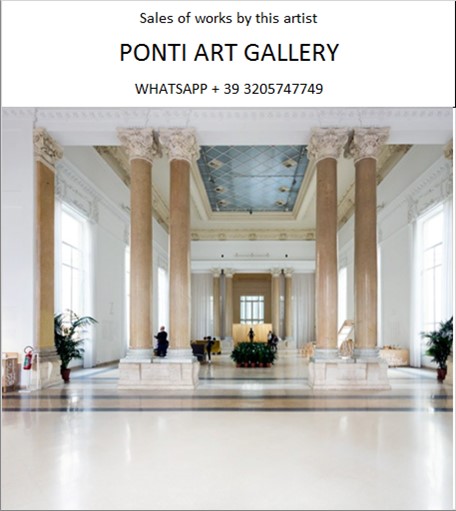Ponti Art Gallery is interested in buying and selling works
of art by this artist.

Martha Boto Biography
Martha Boto was an Argentine artist renowned for her pioneering work in kinetic and optical art. Born on December 27, 1925, in Buenos Aires, Argentina, Boto was introduced to the world of art at a young age, inheriting a passion for theater, art, and music from her family, which had roots in Spain. Her mother and grandfather, in particular, were influential in fostering her early interest in the arts.
Boto's formal education in art began at the National School of Fine Arts in Buenos Aires, where she graduated in 1946 with the title of Professor of Drawing. Her academic journey continued at the renowned Graduate School of Fine Arts, where she deepened her knowledge and graduated in 1950, receiving the prestigious Ernesto de la Carcova award, which recognized her as one of the best students of her class.
During the late 1940s and early 1950s, Boto's artistic career began to take shape. She was awarded two painting prizes in 1947, which underscored her talent and the success of her work among her contemporaries. Initially, her paintings captured landscapes and scenes of everyday life, but by 1954, she had shifted her focus to geometric abstraction. Between 1951 and 1960, Boto held eight solo exhibitions that showcased her geometric art.
Boto's artistic evolution continued as she became involved with the concrete art movement in Buenos Aires. In 1956, she approached the advocates of concrete art, aiming to perpetuate the avant-garde spirit established by groups such as Arte Concreto Invención, Madi, and Arte Nuevo. It was during this period that she met Gregorio Vardanega, who would become her lifelong companion and collaborator.
In 1957, Boto co-founded the Group of Non-Figurative Artists of Argentina (ANFA), participating in numerous concrete art events. Her work during this time began to explore the relationship between art and space, leading to the creation of her first mobile Plexiglas structures.
The year 1959 marked a significant turning point in Boto's career when she moved to Paris with Vardanega. This move opened new horizons for her artistic expression, and she quickly became integrated into the Parisian art scene. In 1960, she participated in the I Biennale de Paris, which marked the beginning of her career as a kinetic artist.
Boto's work in the 1960s was characterized by her use of industrial materials, such as electric motors, Plexiglas, aluminum, and stainless steel, to create sculptures that incorporated movement, light, and color. She was among the first artists in Buenos Aires to use movement as a component in her sculptures, and her work was promoted by the influential Galerie Denise René in Paris.
Throughout the 1960s and beyond, Boto participated in numerous exhibitions in France and around the world. Her kinetic sculptures and installations were well-received, and she became known for her ability to induce contemplation through mechanization and lyricism. Boto sought to create art that could evoke various emotions and psychological reactions, aiming for her work to serve as a form of spiritual medicine.
In the early 1970s, Boto's work transitioned away from kinetic structures and returned to painting and more traditional sculptural forms. However, her legacy in kinetic and optical art continued to influence the art world. Her works are part of important collections in institutions such as the Albright-Knox Art Gallery in Buffalo, New York, the Los Angeles County Museum of Art (LACMA), the Musée d'Art Moderne de Paris, and the Museo Nacional de Bellas Artes in Buenos Aires, among others.
Martha Boto passed away on October 13, 2004, in Paris, France, leaving behind a rich legacy as a pioneer of kinetic and programmed art. Her innovative approach to sculpture and her exploration of light and movement have cemented her place as a significant figure in the history of 20th-century art.
Martha Boto Quotes and Sales
of Works
Ponti Art Gallery selects and deals with paintings by the
artist. Upon request, we provide free estimates and
evaluations, communicate prices, quotations, and current
market values.
If you are interested in BUYING or SELLING works by the
artist, contact us immediately.
If you wish to sell or receive an evaluation of the
works:
Send us a frontal photo of the painting, one of the back,
and one of the signature. Also, indicate the dimensions of
the work. Inform us about the purchase origin of the work
and any kind of available documentation (purchase
receipts, certificates of authenticity, publications). One
of our operators will respond to you on the same day. We
guarantee maximum confidentiality and extreme
professionalism.
If you wish to purchase works by the painter: Contact us
and let us know your request. We will inform you about the
available works. We also offer the possibility to
subscribe to our NEWSLETTER, through which you will be
informed at the beginning of each month about the latest
acquisitions of the art gallery.
You can send us pictures of the work:
